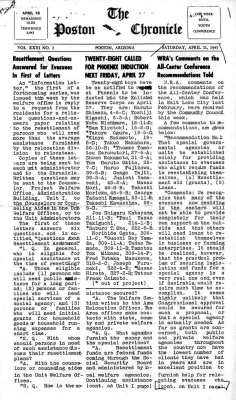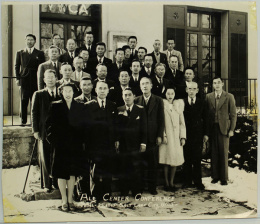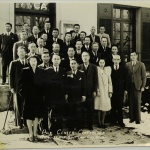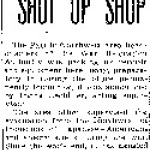All Center Conference
From February 16 to 22, 1945, over thirty individuals gathered in Salt Lake City, Utah as representatives or secretaries for at least seven of the War Relocation Authority (WRA) camps. Their aim was to discuss relocation in the light of the announcement made on December 17, 1944: the Western Defense Command's termination of the West Coast exclusion order and the WRA's closure of all its camps by January 2, 1946. Their exchange of opinions was heated and what emerged was a clear picture that many, if not most of the seventy-five thousand West Coast Japanese Americans still residing in the concentration camps did not want to leave. Why? [1]
Meeting Background
Obviously, the WRA dragging its feet was not the problem. In fact, WRA officials wanted Japanese Americans to take advantage of this opportunity to live as free people again after suffering through three years of forcible removal and confinement in desolate areas. Director Dillon Myer believed Japanese Americans were loyal to America and should not have been confined to such camps at all. He further thought the camps were detrimental—it made them more dependent on government welfare and less independent economically—and worse, encouraged them to stick together as an ethnic group rather than scatter geographically and assimilate into mainstream American life. Myer wanted Japanese Americans to leave the camps and secure employment and housing before some sixteen million Americans in uniform returned to civilian life at the end of the war, making their resettlement even more difficult. [2]
However, Japanese American reluctance to relocate outside permanently was understandable. They were concerned relocation outside prior to the end of the war would disqualify them for war reparations from Japan. The Japanese government might frown upon their employment in a wartime economy, and disqualify them from reparations payments if they participated in American war bonds sales. Another problem was personal safety—how to withstand physical violence aimed at them. During the Conference, a Nisei who relocated to Fresno, California was shot at and his house burned, triggering fears that this was a prelude of more violence to come. (See Terrorist incidents against West Coast returnees ). As American forces drew closer to the home islands of Japan, they anticipated the fighting would turn more desperate and bloody, resulting in greater losses of American lives, and thus greater antagonism towards all Japanese including themselves. [3]
Despite these fears, many Japanese Americans considered relocation once the war turned decisively against Japan. By late summer of 1944, Saipan had been invaded and taken and American B-29 bombers were already flying off of nearby Tinian Island and bombing Japan proper in October–November. That fall, American forces had already badly mauled the Imperial Japanese Navy at Leyte Gulf, and by mid-February of 1945, its ground forces were making their way to Manila, with preparations for an invasion of Okinawa already underway. Meanwhile the American Navy had just launched its assault on Iwo Jima. Japanese Americans could therefore see by mid-February 1945, their postwar employment opportunities within the Japanese empire dissipating as Japan had obviously lost the empire. [4]
Differing Views
Hence, representatives from the majority of the WRA camps gathered in Salt Lake City, Utah for the All Center Conference. Convened by Topaz City Council Chairperson Masaru Narahara, the conference delegates first established the structure of their organization which some at least had envisioned as replacing the Japanese Associations and the Japanese American Citizens League of the prewar era. In apportioning votes, they made each camp equal, granting one vote per WRA camp even though two or more representatives per camp attended the conference. They established a Public Relations Committee, staffed by one representative per WRA camp, to ensure that only the "correct" or official version of information regarding the Conference's proceedings and resolutions was disseminated to the incarcerated population. [5]
But the conference participants were deeply divided over how to deal with Myer's announced plan to terminate the WRA camps by January 2, 1946. Some refused to plan for relocation outside and encouraged others to hold fast and not move out of the WRA camps. They believed the WRA should keep its original promise made by Milton Eisenhower , Myer's predecessor, to maintain the camps for a short period of time beyond the duration of the war. They pointed to the small number of individuals who had successfully relocated, making closure of the camps practically impossible by the deadline of January 2. They projected a hostile atmosphere even if Japanese Americans relocated in 1945, and feared forfeiture of their only foreseeable war reparations from the Imperial Japanese government if relocation plans were made without consulting Spanish Embassy officials. (The Spanish Embassey represented the Imperial Japanese government in all matters related to Japanese citizens among the incarcerated population.) For them, therefore, the aim of the conference was to craft a joint statement demanding of Dillon Myer an extension of the deadline for termination of all WRA camps. Since three-quarters of the representatives were born in Japan, the "refuseniks" (my own term) reflected a stance consistent with their Japanese nationality status and pessimistic projections of the progress of the war. [6]
Others, however, believed all incarcerated Japanese Americans should leave the camps before the January 2 deadline. Labeling their opponents as "reactionaries" and themselves as "liberals," these delegates believed Dillon Myer's announced deadline was fixed and "demanding" an extension unwise. Instead, they favored "asking" for greater economic assistance in relocation and "suggesting" a stronger safety net for those who might fail outside, or in fact, may not move out due to health, age, or other personal reasons. They thought that the remaining incarcerated Japanese American population had, after all, declared themselves "loyal" to the United States during the loyalty registration of 1943, and thus should accept the consequences of their decision—they should obey the federal government's order to relocate. Hence, their response to Myer through a joint statement should therefore focus primarily on "suggesting" ways to increase the pace of relocation such as expanding the number of Japanese American staff members at the WRA relocation offices, increasing the financial assistance for the move, and streamlining the dissemination of employment information. [7]
In-between were the moderates. They believed relocation was a matter of individual choice rather than of government fiat, and that options should exist for all regardless of their stance. For those who choose to relocate, they can obey the WRA dictates and, using their assistance, should be able to relocate. Those who are loyal to Japan and choose to wait for the peace treaty, should be allowed to reside in the Department of Justice camps such as the one in Crystal City , Texas, or Santa Fe , New Mexico. Termination, therefore, on January 2, should prove not a problem for either group, a choice which only individuals can make. [8]
Results and Aftermath
The joint statement the All Center Conference delegates prepared reflected the conflicting viewpoints of the representatives. It began with a direct appeal "asking" rather than "demanding" to keep the camps open beyond the war's end, "…with a view to providing residents with necessities, facilities and services on at least equal levels as in the past." Their statement then recited ten "facts" that supported their position, particularly the difficulties relocation posed for those in the WRA camps and offered twenty numbered "suggestions" for Myer to provide greater economic and logistical assistance in their relocation. It ended with a final unnumbered suggestion for the WRA to verify for itself the "facts" and "suggestions" of the joint statement. [9]
Assessments of the success or failure of the All Center Conference varied. Some who favored extension of camp closure anticipated little in the way of specific accomplishments but nevertheless saw in the conference the beginning point of negotiating with the WRA to delay camp closure beyond the deadline to provide more time for resettlement planning. Others who favored rapid relocation before the deadline saw in it hope—the Conference signaled the last gasp of Issei oppositional politics in the WRA camps. Still others saw no change at all effected by the conference except perhaps to provide the representatives with a good time. As one put it, "They spent our money and got nothing out of it. Maybe they drank whiskey with it." [10]
For More Information
Hayashi, Brian Masaru. Democratizing the Enemy: The Japanese American Internment . Princeton, NJ: Princeton University, 2004.
Hirabayashi, Lane Ryo, ed. Richard Nishimoto , Inside an American Concentration Camp: Japanese American Resistance at Poston, Arizona . Tucson, AZ: University of Arizona, 1995.
Myer, Dillon. Uprooted Americans: The Japanese Americans and the War Relocation Authority during World War II . Tucson: University of Arizona Press, 1971.
Taylor, Sandra C. Taylor. Jewel of the Desert: Japanese American Internment at Topaz . Berkeley: University of California, 1993.
Footnotes
- ↑ Lane Ryo Hirabayashi, ed., Richard Nishimoto, Inside an American Concentration Camp: Japanese American Resistance at Poston, Arizona (Tucson, AZ: University of Arizona, 1995),183; Brian Masaru Hayashi, Democratizing the Enemy: The Japanese American Internment (Princeton, NJ: Princeton University, 2004), 197.
- ↑ Dillon Myer, Uprooted Americans: The Japanese Americans and the War Relocation Authority during World War II (Tucson: University of Arizona Press, 1971), 113-18, 208-09.
- ↑ Hayashi, Democratizing the Enemy , 194, 196, 202, 203.
- ↑ Ibid., 194-95.
- ↑ Hirabayashi, Richard Nishimoto , 183-85.
- ↑ Hayashi, Democratizing the Enemy , 197-98.
- ↑ Ibid., 197-98.
- ↑ Ibid., 199-200.
- ↑ Hirabayashi, Richard Nishimoto , 198-207.
- ↑ Hayashi, Democratizing the Enemy , 200.
Last updated Dec. 2, 2023, 6:06 a.m..

 Media
Media








